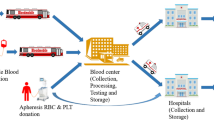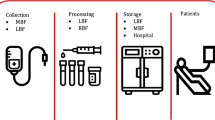Abstract
Blood is a living tissue of unique value to the human body and has special features with short shelf life, unpredictable supply, and stochastic demand. The efficiency of blood management affects the quality of medical services. Scholars pay more attention to demand uncertainty than to supply uncertainty in blood supply chain management, which leads to a lack of research on supply uncertainty in such management. We take supply uncertainty into account and discuss three different uncertainty scenarios: optimistic, average, and pessimistic supply scenarios. Different supply scenarios will affect not only the quantity of orders but also the inventory freshness. To balance the fairness of the old inventory allocation, we designed a hybrid allocation policy of old stocks by order share and batch allocation of other stocks by hospital priority. The simulation results reveal the direct and cross effects of supply uncertainty, life cycle, and old inventory ratio (OIR) policy on the system-wide outdating rate. First, for the effect of supply uncertainty, when it is smaller, the system’s outdate rate grows with the increase of its intensity, but when it is larger, the outdate rate hardly grows and even decreases in intensity. Especially, when the supply uncertainty is larger, the expected supply scenarios have no significant effect on the outdate rate. Second, for the effect of product shelf life, when the shelf life is longer, the OIR policy can significantly reduce the system’s outdate rate in the optimistic or average supply scenarios and has little impact on the rate in the pessimistic supply scenario. Third, for the effect of the OIR policy, when the intensity of supply uncertainty is smaller, the OIR policy leads to a large increase in the system’s outdate rate as supply uncertainty grows. However, when the intensity of supply uncertainty is larger, the range of increase in system outdate rate further increases in the optimistic scenario. In contrast, in the pessimistic scenario, it will decrease. Besides, the OIR policy will have no significant effect on the outdate rate when the supply uncertainty is smaller.












Similar content being viewed by others
References
Ahmadi, A., & Najafi, M. (2017). Blood inventory management in hospitals: Considering supply and demand uncertainty and blood transshipment possibility. Operations Research for Health Care, 13, 43–56.
Beliën, J., & Forcé, H. (2012). Supply chain management of blood products: A literature review. European Journal of Operational Research, 217(1), 1–16.
Blake, J., Heddle, N., Hardy, M., & Barty, R. (2009). Simplified platelet ordering using shortage and outdate targets. https://www.researchgate.net/publication/268373290_Simplified_Platelet_Ordering_Using_Shortage_and_Outdate_Targets.
Blake, J. T. (2017). Determining the inventory impact of extended-shelf-life platelets with a network simulation model. Transfusion, 57(12), 3001–3008.
Chen, X., Liu, L., & Guo, X. (2021). Analysing repeat blood donation behavior via big data. Industrial Management & Data Systems, 121(2), 192–208.
Chen, X., Wu, S., & Guo, X. (2020). Analyses of factors influencing Chinese repeated blood donation behavior: The delivered value theory perspective. Industrial Management & Data Systems, 120(3), 486–507.
Duan, Q., & Liao, T. W. (2013). A new age-based replenishment policy for supply chain inventory optimization of highly perishable products. International Journal of Production Economics, 145(2), 658–671.
Duan, Q., & Liao, T. W. (2014). Optimization of blood supply chain with shortened shelf lives and ABO compatibility. International Journal of Production Economics, 153, 113–129.
Ekici, A., Özener, O.Ö., & Çoban, E. (2018). Blood supply chain management and future research opportunities. Operations Research Applications in Health Care Management.
Fahimnia, B., Jabbarzadeh, A., Ghavamifar, A., & Bell, M. (2017). Supply chain design for efficient and effective blood supply in disasters. International Journal of Production Economics, 183, 700–709.
Fontaine, M. J., Chung, Y. T., Rogers, W. M., Sussmann, H. D., Quach, P., Galel, S. A., Goodnough, L. T., & Erhun, F. (2009). Improving platelet supply chains through collaborations between blood centers and transfusion services. Transfusion, 49(10), 2040–2047.
Frank, S. M., Abazyan, B., Ono, M., Hogue, C. W., Cohen, D. B., Berkowitz, D. E., Ness, P. M., & Barodka, V. M. (2013). Decreased erythrocyte deformability after transfusion and the effects of erythrocyte storage duration. Anesthesia and Analgesia, 116(5), 975–981.
Geng, W., Qiu, M., & Zhao, X. (2010). An inventory system with single distributor and multiple retailers: Operating scenarios and performance comparison. International Journal of Production Economics, 128(1), 434–444.
Ghandforoush, P., & Sen, T. K. (2010). A DSS to manage platelet production supply chain for regional blood centers. Decision Support Systems, 50(1), 32–42.
Gunpinar, S. (2013). Supply chain optimization of blood products. Dissertations & Theses, Gradworks.
Guo, X., & Chen, X. (2022). Impact of WeChat public platforms on blood donation behavior: A big data-based research. Industrial Management & Data Systems, 122(4), 983–1001.
Haijema, R., van Dijk, N., van der Wal, J., & Sibinga, C. S. (2009). Blood platelet production with breaks: Optimization by SDP and simulation. International Journal of Production Economics, 121(2), 464–473.
Hlioui, R., Gharbi, A., & Hajji, A. (2017). Joint supplier selection, production and replenishment of an unreliable manufacturing-oriented supply chain. International Journal of Production Economics, 187, 53–67.
Hosseinifard, Z., & Abbasi, B. (2018). The inventory centralization impacts on sustainability of the blood supply chain. Computers & Operations Research, 89, 206–212.
Jones, R., Davey, R., & Valinsky, J. E. (2002). Impact of the 9/11 disaster on blood donations in the New York area. Transfusion, 42S, 115S.
Katsaliaki, K., & Brailsford, S. C. (2007). Using simulation to improve the blood supply chain. Journal of the Operational Research Society, 58(2), 219–227.
Kazemi, S. M., Rabbani, M., Tavakkoli-Moghaddam, R., & Shahreza, F. A. (2017). Blood inventory-routing problem under uncertainty. Journal of Intelligent & Fuzzy Systems, 32(1), 467–481.
Kleywegt, A. J., Shapiro, A., & Homem-De-Mello, T. (2001). The sample average approximation method for stochastic discrete optimization. Siam Journal on Optimization, 12(2), 479–502.
Li, Q., & Yu, P. (2014). Multimodularity and its applications in three stochastic dynamic inventory problems. Manufacturing & Service Operations Management, 16(3), 455–463.
Li, Y. C., & Liao, H. C. (2012). The optimal parameter design for a blood supply chain system by the Taguchi method. International Journal of Innovative Computing, 8(11), 7697–7712.
Luo, Z., & Chen, X. (2021). Blood order and collection problems with two demand classes and emergency replenishment. Journal of the Operational Research Society, 72(3), 501–518.
Luo, Z., & Chen, X. (2022). Ordering policies for heterogeneous platelets demand with unreliable supply and substitution. Journal of the Operational Research Society, 73(4), 919–935.
Ma, K. M. (2018). Xin C. W. [EB/OL]. Available at: http://chuansong.me/n/2207805443921
Manuj, I., & Mentzer, J. T. (2008). Global supply chain risk management strategies. Journal of Business Logistics, 29(1), 133–155.
Miller, K. D. (1992). A framework for integrated risk management in international business. Journal of International Business Studies, 23(2), 311–331.
Mustafee, N., Taylor, S. J. E., Katsaliaki, K., & Brailsford, S. (2009). Facilitating the analysis of a UK national blood service supply chain using distributed simulation. SIMULATION, 85(2), 113–128.
Nagurney, A., Masoumi, A. H., & Yu, M. (2012). Supply chain network operations management of a blood banking system with cost and risk minimization. Computational Management Science, 9(2), 205–231.
Nahmias, S. (1982). Perishable inventory-theory-a review. Operations Research, 30(4), 680–708.
National Health and Family Planning Commission (NHFPC) of the PRC. (2012). Voluntary blood donation work progress in China. Available at: http://www.moh.gov.cn/mohyzs/s3590/201206/55073.shtml
NHS Direct. (2007). Online health encyclopedia [EB/OL]. Available at: http://www.nhsdirect.nhs.uk/en.aspx?articleID=552
Prastacos, G. P. (1984). Blood inventory management: An overview of theory and practice. Management Science, 30(7), 777–800.
Ramezanian, R., & Behboodi, Z. (2017). Blood supply chain network design under uncertainties in supply and demand considering social aspects. Transportation Research Part E Logistics & Transportation Review, 104, 69–82.
Roni, M. S., Eksioglu, S. D., Jin, M., & Mamun, S. (2016). A hybrid inventory policy with split delivery under regular and surge demand. International Journal of Production Economics, 172, 126–136.
Sabitha, D., Rajendran, C., Kalpakam, S., & Ziegler, H. (2016). The value of information sharing in a serial supply chain with AR (1) demand and non-zero replenishment lead times. European Journal of Operational Research, 255(3), 758–777.
Salem, R. W., & Haouari, M. (2017). A simulation-optimization approach for supply chain network design under supply and demand uncertainties. International Journal of Production Research, 55(7), 1845–1861.
Sayers, M., Centilli, J., & Sutor, L. J. (2011). Implications for management of a community blood program inventory if the red blood cell shelf life is shortened. Transfusion, 51, 241A.
Sirelson, V., & Brodheim, E. (1991). A computer planning model for blood platelet production and distribution. Computer Methods and Programs in Biomedicine, 35(4), 279–291.
Stanger, S. H. W., Yates, N., Wilding, R., & Cotton, S. (2012). Blood inventory management: Hospital best practice. Transfusion Medicine Reviews, 26(2), 153–163.
Syntetos, A. A., Babai, Z., Boylan, J. E., Kolassa, S., & Nikolopoulos, K. (2016). Supply chain forecasting: Theory, practice, their gap and the future. European Journal of Operational Research, 252(1), 1–26.
United Nations International Strategy for Disaster Reduction Secretariat (UNISDR). 2012. Press Release [Online] Available at: http://www.unisdr.org/archive/24588/
Van Dijk, N., Haijema, R., Van Der Wal, J., & Sibinga, C. S. (2009). Blood platelet production: a novel approach for practical optimization. Transfusion, 49(3), 411–420.
Zhao, X., Xie, J., & Leung, J. (2002). The impact of forecasting model selection on the value of information sharing in a supply chain. European Journal of Operational Research, 142(2), 321–344.
Zhou, D., Leung, L. C., & Pierskalla, W. P. (2011). Inventory management of platelets in hospitals: Optimal inventory policy for perishable products with regular and optional expedited replenishments. Manufacturing & Service Operations Management, 13(4), 420–438.
Acknowledgements
This research is partially supported by National Key R&D Program of China (No. 2020YFB1711900).
Author information
Authors and Affiliations
Corresponding author
Ethics declarations
Conflict of interest
No potential conflict of interest was reported by the authors.
Additional information
Publisher's Note
Springer Nature remains neutral with regard to jurisdictional claims in published maps and institutional affiliations.
Appendices
Appendix A
See Table
7,
8,
9,
10,
11,
12,
13,
14,
15,
16,
17,
18,
19,
20,
21,
22,
23,
24.
Appendix B
See Table
25,
26,
27,
28,
29,
30,
31,
32,
33,
34,
35 and
36.
Appendix C
See Table
37 and
38.
Appendix D
See Fig.
13 and Table
39,
40,
41,
42,
43,
44.
Appendix E
See Table
45,
46,
47,
48,
49 and
50.
Appendix F
See Fig.
14 and Table
51,
52.
Rights and permissions
Springer Nature or its licensor (e.g. a society or other partner) holds exclusive rights to this article under a publishing agreement with the author(s) or other rightsholder(s); author self-archiving of the accepted manuscript version of this article is solely governed by the terms of such publishing agreement and applicable law.
About this article
Cite this article
Hu, B., Tian, L., Zhao, K. et al. Optimization of blood supply chains under different supply scenarios. Ann Oper Res 335, 597–633 (2024). https://doi.org/10.1007/s10479-023-05778-5
Received:
Accepted:
Published:
Issue Date:
DOI: https://doi.org/10.1007/s10479-023-05778-5






